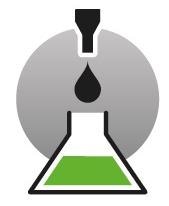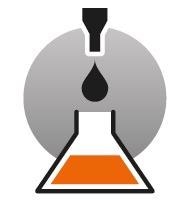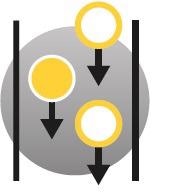Battery research entails the development process from concept and theory validation of new materials to the quality control and characterization of raw materials and finished batteries.
Progress in the pursuit of higher energy, power density, and more efficient energy storage is dependent on sophisticated instrumentation for the characterization of cells and materials. To enable and support your research, Metrohm supplies the user with top-quality analytical instruments, know-how, and superior on-site service.
The parameters of interest and which method can be used to analyze them with Metrohm instrumentation are detailed in the table below.
Source: Metrohm AG
| Sample |
Parameter of
interest |
Analysis
technique |
Metrohm
Application
Documents |
Anode
(raw materials) |
Water content |
Karl
Fischer titration |
AB-434 |
| Eluated anions and cations |
Ion
chromatography |
|
Cathode
(raw materials) |
Purity of lithium salts (LiOH, Li2CO3, LiNO3, LiCl) |
Titration |
AN-T-215,
AN-T-216,
AN-T-181 |
| Impurities in lithium salts (e.g., sodium, ammonium) |
Ion
chromatography |
AN-C-189 |
| Ni, Co, Mn content in solution for cathode material production (single metal or mixture) |
Titration,
Voltammetry |
AN-T-218 |
| Cobalt, nickel, iron, manganese in various cathode material |
Titration |
|
| Water content |
Karl
Fischer titration |
AB-434 |
| Eluated anions and cations |
Ion
chromatography |
|
| Through-plane tortuosity |
Electrochemistry |
AN-BAT-011 |
| Electrolytes, electrolyte additives and electrolyte solvents |
Water content |
Karl Fischer titration |
AB-434 |
| Cations and anions in electrolyte (e.g., LiPF6) |
Ion
chromatography |
AN-C-037,
AN-CS-011,
AN-N-012 |
| Decomposition products of LiPF6 |
Ion
chromatography |
AN-S-372 |
| Electrolyte resistance |
Electrochemistry |
|
| Solid electrolyte interface investigation |
Electrochemistry |
AN-BAT-010 |
| Diffusion coefficient |
Electrochemistry |
AN-BAT-009 |
| Lithium ion transference number |
Electrochemistry |
AN-BAT-012 |
| HF content in electrolyte |
Titration |
|
| Separators |
Water content |
Karl Fischer titration |
AB-434 |
| Eluated anions and cations |
Ion
chromatography |
|
| MacMullin number |
Electrochemistry |
AN-BAT-006 |
Finished
batteries |
Voltage characteristics upon charge and discharge |
Electrochemistry |
AN-BAT-001,
AN-BAT-002 |
| Cycling performance and coulombic efficiency |
Electrochemistry |
WP-052 |
| Cycle and calendar life evaluation |
Electrochemistry |
|
| Battery capacity and power |
Electrochemistry |
|
| State of charge, depth of discharge and state of health |
Electrochemistry |
|
| Internal battery resistance |
Electrochemistry |
|
| Charge transfer resistance |
Electrochemistry |
|
| Diffusion coefficient (GITT and PITT) |
Electrochemistry |
AN-BAT-003,
AN-BAT-004 |
| Eluated anions and cations |
Ion chromatography |
|
|
Analysis Methods

Image Credit: Metrohm AG
Electrochemistry – Ideal for Studying the Performance of Batteries and Battery Materials
The specially designed potentiostats/galvanostats from Metrohm are employed for the characterization of battery raw materials, in addition to finished batteries. Electrochemical measurements are based on highly accurate control and measurements of electrical charge, voltage, impedance, or current.
Voltammetry is a highly sensitive technique that has LODs in the ppb range. It can be utilized for the analysis of electrochemically active substances, like organic or inorganic ions.
For instance, voltammetry enables the simultaneous determination of cobalt, nickel, and manganese in cathode materials. This method can be combined with a large variety of applications and has short analysis times and high precision with comparatively low costs of the instrumentation required.

Image Credit: Metrohm AG
Titration – Specific, Accurate, and Reliable
Potentiometric titration is ideally suited for establishing the purity of lithium salts or metals which are employed in cathode materials, like cobalt, iron, manganese, or nickel. It is applied to analyze standard solutions utilized for the preparation of cathode materials or finished cathode materials.
Titration does not require dilution of such samples, unlike competing techniques such as ICP-MS or AAS, so the results which are gathered by titration are more accurate and reliable. Compared with ICP-MS or AAS, Maintenance and running costs are also considerably lower.

Image Credit: Metrohm AG
Karl Fischer Titration – The Preferred Method for Water Determination
As water reacts with the conducting salt, e.g., LiPF6, to form hydrofluoric acid, lithium-ion batteries must be totally free of water (concentration of H2O < 20 mg/kg).
For establishing water content at trace levels, sensitive coulometric Karl Fischer titration is the perfect technique. For solids, water determination is performed by utilizing the Karl Fischer oven technique. This is where residual moisture in the sample is evaporated and transferred to the titration cell, where it is subsequently titrated.

Image Credit: Metrohm AG
Ion Chromatography – Highly Efficient Multi-Parameter Analysis of Electrolytes and Metals Salts
Ion chromatography (IC) is a precise and efficient multi-parameter technique that can be used to quantify decomposition products in electrolytes, impurities in lithium salts, and anions and cations in eluates of numerous battery raw materials.

This information has been sourced, reviewed and adapted from materials provided by Metrohm AG.
For more information on this source, please visit Metrohm AG.